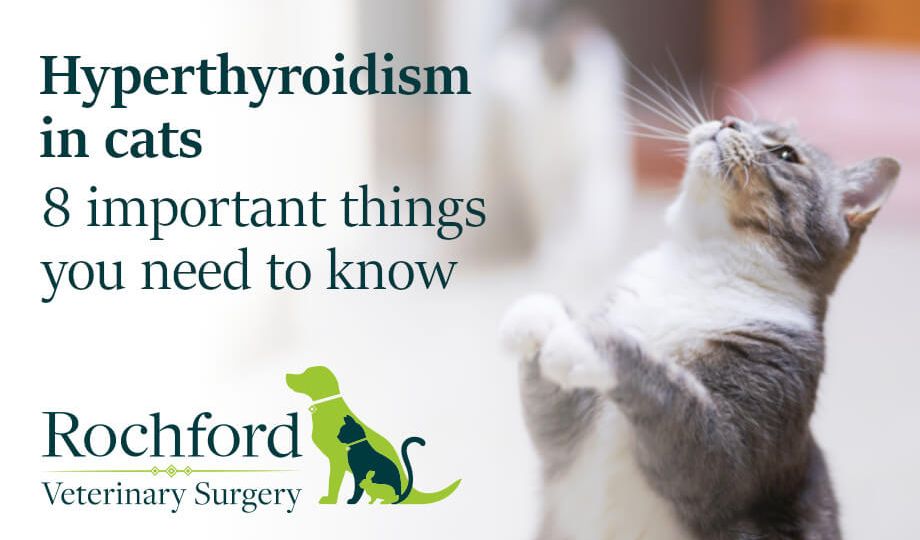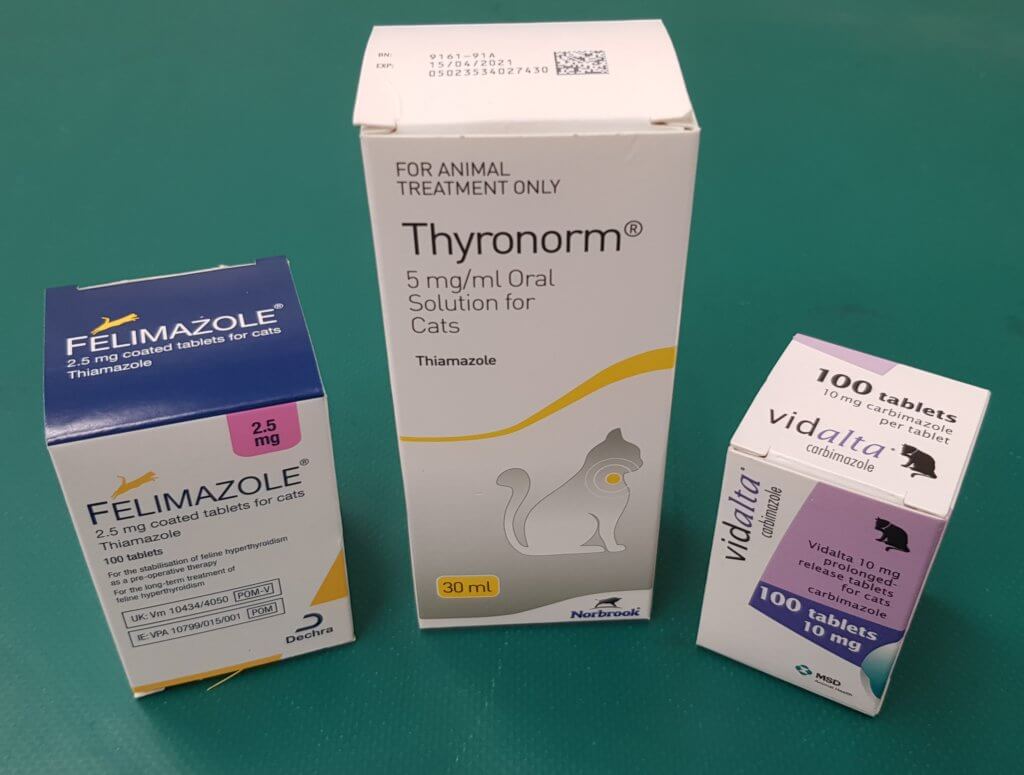
Hyperthyroidism is a common condition diagnosed in older cats. It causes weight loss, often with a ravenous appetite. Here are 8 important things you need to know about hyperthyroidism in cats.
1. What are thyroid glands?
The thyroid glands are located in the neck. Cats have two and they sit one on either side of the trachea. They are responsible for producing the thyroid hormone. This hormone regulates many things in the body including heart rate, metabolic rate, body weight, muscle strength and more.

2. What is hyperthyroidism?
Hyperthyroidism, also known as overactive thyroid, is when the body produces too much thyroid hormone for the amount that the body normally needs. It can lead to a number of changes in the body.
3. What causes hyperthyroidism in cats?
Hyperthyroidism in cats is usually cause by a benign (non-cancerous) growth in the thyroid gland called an adenoma or thyroid hyperplasia. In less than 2% of cases it is caused by a cancerous growth called an adenocarcinoma. In most cases, in fact over 70%, both thyroid glands are involved and so the disease is bilateral. The underlying cause of these growths is currently unknown.
4. What are the clinical signs seen?
The main clinical signs seen are:
- Weight loss
- Increased appetite and begging for food
- Changes in behaviour
- Vomiting
- Unkempt and messy fur
- Increased thirst
- Increased heart rate
Not all cats will show every sign and these signs are often not specific to hyperthyroidism.

5. How is hyperthyroidism in cats diagnosed?
Hyperthyroidism in cats is diagnosed by blood tests to check the levels of the main thyroid hormone. In most cases the thyroid hormone (T4) will be increased on blood results. However in some cats the level may be normal and further testing may need to be run to diagnose the disease. There may be other changes seen on blood work that may be associated with hyperthyroidism such as increased liver enzymes. A urine sample may be required to check for other signs of concurrent disease such as kidney disease.
6. What are the treatment options?
There are two options for treatment that will most likely lead to a cure. The other options for treatment involve long-term, life-long medication and management of the disease.
Medical management is achieved with life-long medication either in the form of a daily liquid or tablets. These drugs reduce the production of the thyroid hormone. These medications are both safe and effective; they require monitoring with blood tests to check the correct dosing. Side effects are uncommon, but those that may be seen are poor appetite, vomiting and lethargy and these effects often resolve after the first few weeks of treatment.

Surgical management involves removal of the affected glands. If both are affected then the surgery is likely to be staged, meaning two separate surgeries to remove each gland. This is because the parathyroid gland can be found next to the thyroid gland and if disturbed there can be problems with calcium metabolism which is potentially life threatening. By staging the surgery this problem is much less likely to occur. Due to this risk often cats will be kept in or closely monitored after surgery with repeat bloods. With this small risk in mind the surgery is generally very successful and in most cases provides a life long cure. Most cats will require stabilisation with medication before surgery.
Radioactive iodine therapy is another option for cure. The only place in the body that uses iodine is the thyroid gland. The patient is given radioactive iodine which irradiates the abnormal tissue and destroys it. The radioactive iodine is given by one single injection and the cat will need to remain in hospital whilst they are temporarily radioactive. This treatment is carried out at specialist centers and so carries a higher price. However it is curative in 95% of cases and has very little side effects. For more information click here.
For cats that are indoor only there is also the option of a specially formulated food. This food has restricted iodine levels so the cat will only get what it needs for daily maintenance. This diet works well but must be fed as the only source of food. Due to this it is often impractical for most cats.
7. What is the prognosis?
The prognosis for most hyperthyroid cats is good with the correct treatment. However other concurrent conditions may worsen prognosis.
8. What other conditions are associated with hyperthyroidism in cats?
Cats with thyroid disease can often present with concurrent diseases. The most common seen are:
- Kidney disease
Thyroid disease will often mask the signs of kidney disease. Once the thyroid disease is treated then the concurrent kidney disease may become apparent. Further blood tests and often urine samples will be required to test for this concurrent disease. - Hypertension (high blood pressure)
This can lead to several other problems including blindness. Often cats with thyroid disease will have their blood pressure measured in case they need to be treated for this as well. - Heart disease
Due to the increased level of thyroid hormone’s affect on the heart, commonly cats will present with heart disease as well. This is because over time the increased heart rate leads to thickening of the heart muscle. If the thyroid disease is left untreated this can in time lead to heart failure. However if treated quickly enough then in some cases the heart will improve almost back to normal.
If you are concerned that you cat may be showing signs of hyperthyroidism then phone on 01702 545558 today to book an appointment to see one of our vets.

